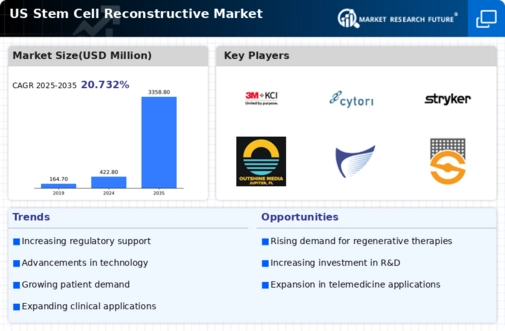Regulatory Support for Stem Cell Research
Regulatory support for stem cell research is playing a pivotal role in shaping the landscape of the stem cell-reconstructive market. The US government has implemented policies that encourage research and clinical trials involving stem cell therapies, providing a framework for safe and ethical practices. In 2025, funding for stem cell research is anticipated to reach $1 billion, reflecting the commitment to advancing this field. This regulatory environment not only fosters innovation but also instills confidence among investors and healthcare providers. As a result, the stem cell-reconstructive market is likely to benefit from increased research activities and the introduction of new therapies, ultimately enhancing treatment options for patients.
Rising Demand for Reconstructive Procedures
The increasing prevalence of congenital anomalies, traumatic injuries, and age-related conditions is driving the demand for reconstructive procedures in the stem cell-reconstructive market. According to recent data, approximately 1 in 33 infants is born with a congenital anomaly in the US, necessitating advanced reconstructive solutions. Furthermore, the aging population, projected to reach 77 million by 2034, is likely to require more reconstructive surgeries, thereby expanding the market. This growing demand for effective and innovative treatments is pushing healthcare providers to explore stem cell therapies, which offer potential for improved healing and recovery. As a result, the stem cell-reconstructive market is expected to witness substantial growth, with an estimated CAGR of 15% over the next five years.
Increased Investment in Research and Development
Investment in research and development (R&D) within the stem cell-reconstructive market is on the rise, as stakeholders recognize the potential of stem cell therapies to revolutionize reconstructive procedures. In 2025, R&D spending in the US healthcare sector is projected to exceed $200 billion, with a significant portion allocated to regenerative medicine. This influx of funding is likely to accelerate the development of innovative stem cell applications, enhancing treatment options for patients. Moreover, collaborations between academic institutions and private companies are fostering advancements in stem cell technologies, which may lead to breakthroughs in reconstructive surgery. As a result, the stem cell-reconstructive market is positioned for growth, driven by the continuous evolution of research and clinical applications.
Growing Awareness and Acceptance of Stem Cell Therapies
Public awareness and acceptance of stem cell therapies are increasing, contributing to the expansion of the stem cell-reconstructive market. Educational campaigns and successful case studies have highlighted the benefits of stem cell treatments, leading to a more informed patient population. Surveys indicate that approximately 70% of Americans are now aware of stem cell therapies, with a growing number expressing willingness to consider these options for reconstructive procedures. This shift in perception is likely to drive demand for stem cell-based treatments, as patients seek alternatives to traditional surgical methods. Consequently, healthcare providers are adapting their practices to incorporate these innovative therapies, further propelling the growth of the stem cell-reconstructive market.
Advancements in Stem Cell Isolation and Culturing Techniques
Technological advancements in stem cell isolation and culturing techniques are enhancing the efficacy of treatments within the stem cell-reconstructive market. Innovations such as automated cell processing and improved culture media are enabling the efficient extraction and expansion of stem cells, which is crucial for successful reconstructive procedures. These advancements not only increase the yield of viable stem cells but also improve their therapeutic potential. As a result, healthcare providers are more likely to adopt these techniques, leading to better patient outcomes and increased satisfaction. The ongoing refinement of these technologies is expected to bolster the stem cell-reconstructive market, as they facilitate the development of more effective and personalized treatment options.























Leave a Comment